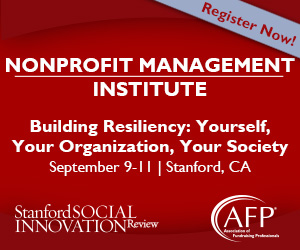ISSUE
Articles on social change from the latest edition of SSIR

Fall 2007
Volume 5, Number 4
Collaboration is the key to impact, according to the fall 2007 issue of Stanford Social Innovation Review. In “Creating High-Impact Nonprofits,” an analysis of 12 high-impact nonprofit organizations reveals that those who form alliances, partnerships, and networks can mobilize every sector of society—government, business, nonprofits, and the public—to be a force for good. Other features examine the inter-related effects of idealistic and pragmatic activism, and the need for foundations to make strategic mission investments to be most effective.
Features
The Power of Strategic Mission Investing
A growing number of foundations are offering low-interest loans, buying into green business ventures, and investing in other asset classes to advance their missions. To bring about real change, foundations need to make strategic mission investments that complement their grantmaking and leverage market forces.
Private Equity, Public Good
Many businesses serving lower income communities languish because they can't raise enough money to fund their growth. To meet their needs, a new breed of private equity investment—development investment capital—has emerged. Although this style of investing is still in its infancy, it's already showing promise.
Harnessing Purity and Pragmatism
As the wall between the nonprofit and corporate worlds crumbles, many social change organizations are asking themselves: Do we stick to our activist guns, or do we cross the divide and work with business? Research suggests that social movements need both kinds of organizations to make the changes they seek.
Creating High-Impact Nonprofits
Conventional wisdom says that scaling social innovation starts with strengthening internal management capabilities. This study of 12 high-impact nonprofits, however, shows that real social change happens when organizations go outside their own walls and find creative ways to enlist the help of others.
Field Report
Boots on the School Ground
An innovative federal project turns retiring military personnel into teachers.
Micro-franchise Against Malaria
How for-profit clinics are healing and enriching the rural poor in Kenya.
Viewpoint
Worst Practices of a Social Entrepreneur
You can learn more from your mistakes than from your successes. Paul Schmitz, president and CEO of Public Allies, gives a sampling of classic foibles of not only social entrepreneurs, but leaders in general.
Portfolio Philanthropy
To ensure that baby boomers' wealth does not fall short of its philanthropic potential, Randall Ottinger suggests applying portfolio theory to make wiser social investments.
Research
The U-Shaped Giving Profile Explained
Most Americans give roughly the same percentage of their incomes.
Butter Your Way to the Top
Flattery, not good governance, reaps corporate directorships – especially for white males.
Books
Q&A
15 Minutes with Hannah Jones
SSIR Academic Editor Jim Phills spoke with Nike’s Hannah Jones about the sportswear giant’s extensive corporate social responsibility programs.
 → This form is for US/Canada subscribers. Are you an international subscriber?
→ This form is for US/Canada subscribers. Are you an international subscriber?
Click here instead.
Subscribe Now!
Subscribers get premium online access (articles with a key) including 9-year archive, downloadable digital edition, quarterly print issues (optional).



































































